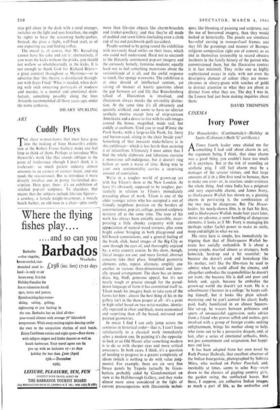ART
Cuddly Ploys
THE sheer woman-hours that must have gone into the making of Jann Haworth's exhibi- tion at the Robert Fraser Gallery make one feel limp to think of them. Perhaps to introduce Miss Haworth's work like that sounds oblique to the point of irrelevance (though I don't think it is irrelevant : so much patient industry almost amounts to an earnest of earnest intent, and one needs the reassurance). But to introduce it more directly involves one in pretty far-fetched des- cription. Here goes, then : it's an exhibition of stitched pop-art sculpture. To elucidate, that means that the subjects include life-size figureilL- a cowboy, a female knight-in-armour, a muscle beach bather, an old man in a chair—plus vastly
more than life-size objects like charm-bracelets and trinket-jewellery; and that they're all made of padded and sewn fabric (including even a cloth cup of tea and patchwork-quilt tea-cakes).
People seemed to be going round the exhibition with nervously fixed smiles on their faces, which one could well understand. Hard not to succumb to the blatantly sentimental pop-art imagery and the curiously homely, feminine medium; equally hard not to feel something monstrous about the verisimilitude of it all, and the awful response to touch, like spongy waxworks. The exhibition is at once devoid of intellectual content, yet raising all manner of knotty questions about the gap between art and life that Rauschenberg talked of. Illusionism is involved, and illusionism always mocks the art-reality distinc- tion. At the same time it's all obviously and quaintly artificial, and seems to have no ulterior aesthetic motive except love of strip-cartoon Americana and a desire to live with its cult-images around the house, magnified, made real, but cuddly as cushions. Used you to read Winnie the Pools books, with a large-as-life Pooh, fat, furry and button-eyed, sitting in the chair beside you? Something of that innocent make-believe is in this exhibition—which is less harsh than accusing it of infantilism. Ultimately I must admit that I find the whole elaborate and laborious exercise a monstrous self-indulgence, but it doesn't ring hollow or seem a waste of time. Being true to your own sentimentality carries a surprising amount of conviction.
We're in a tougher world of grown-up art with Joe Tilson's show at the New London. At least it's obviously supposed to be tougher, par- ticularly in relation to Tilson's immediately preceding phase of work. Tilson is one of the older younger artists who has occupied a sort of friendly neighbour position on the borders of constructionist, pop art, collage, painted-sculpture territory all at the same time. The tone of his work has always been amiably accessible, incor- porating a little chunky carpentry with nice appseciation of natural wood textures, plus some bright colour bringing in both playground and bill-board connotations, and a general feeling of the brash, slick, banal images of the Big City as seen through the eyes of, and thoroughly enjoyed by, a witty country cousin. In this show, though, literal images are out, and more formal, abstract concerns take their place. Simplified geometric elements echo, repeat, alternate, amplify one another in various three-dimensional and later- ally spaced arrangement. The show has an imme- diate, big, bluff, generous appeal, but it's not nearly tough or precise enough for the pared- down language of form it has committed itself to. Tilson needs his imagery back to take care of the forms for him : almost the best thing of his in the gallery isn't in the show proper at all—it's a print in high relief based on two wrist-watches, identic- ally repeated in silver and black, more economical and surprising than all the boxed, mirrored and painted geometries.
In music I find I can only jump across the centuries in historical order—that is, I can't listen satisfactorily to a classical work immediately after a modern one. In painting it's the opposite: to look at an Old Master after something modern is to do so with sharper eyes and more critical awareness. In both cases, I think, it's a question of needing to progress to a greater complexity of idiom (which is nothing to do with value judg- ments). For example, there are six very fine fresco panels by Tiepolo (actually by Giam- battista probably aided by Giandomenico) on view at the Hallsborough Gallery, and they make almost more sense considered in the light of current preoccupations with illusionistic techni- ques, like blending of painting and sculpture, and the use of borrowed imagery, than they would looked at historically. The panels are simulated bas-relief carving in trompe-l'oeil frames, and they lift the groupings and manner of Baroque religious composition right out of context, as an end in themselves (ostensibly to record obscure incidents in the family history of the patron who commissioned them, but the illustrative context is' in fact minimal). They strike one as highly sophisticated essays in style, with not even the descriptive element of colour (they are mono- chromes in silvery-green with •touches of gold) to distract attention to what they are about as distinct from what they are. The day I was in, the Louvre had just been making inquiries about them.
DAVID THOMPSON


































 Previous page
Previous page